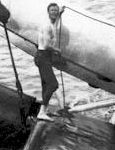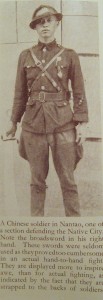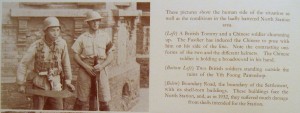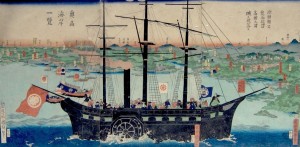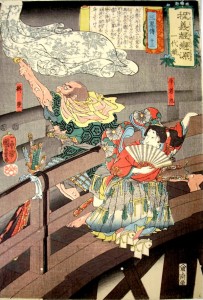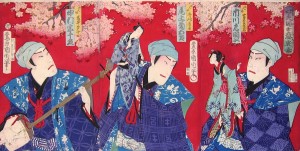One thing I always have to do as a teacher is figure out what books to assign. Since I always find this hard to do, I thought I would think it out in terms of MTV’s Celebrity Deathmatch. So, for this episode we have.
Shen Fu Six Records of a Floating Life
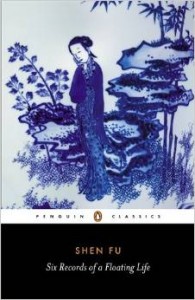
vs
Zhang Daye’s World of a Tiny Insect
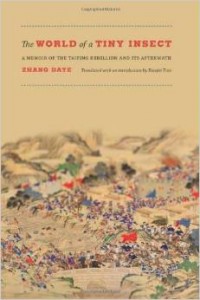
Which is the best book to assign?
Where they fit
Both of these are books for HIST 206 History of East Asia. I suppose they could go in something like a Late Imperial China class, but since so many of my students are replicants I try not to re-use books in different classes. For this type of class I want something short and in paperback that is readable yet deals with some important issues. There are usually lots of memoirs and such in the modern period, but in terms of spacing things out it is nice to have something early modern.
Other things that have more or less gone in this slot over the years are
-Keene trans. Chushingura
Katsu Kokichi Musui’s Story: The Autobiography of a Tokugawa Samurai
Spence, Death of Woman Wang
Schneewind Tale of Two Melons: Emperor and Subject in Ming China (well, I liked it)
Recently Shen Fu has had a long run and I have been pretty happy with it. This Fall, however I shifted to Zhang Daye, and I am not yet sure if I should stick with it.
Both of them are written by low-ranking members of the literate elite. Both of them are “hard to follow” because they “jump around.” Both of them, especially Zhang, require you to read a fair number of footnotes to get all the allusions and references in them.
In Shen Fu we get lots of stuff about his relationship with his family (mostly his father) and his not-very successful career as a government clerk and literatus His main advantage is probably that he is married, and his relationship with his wife is a major part of the book. (It is actually a pretty well-known book in China for that reason.) She, for instance, is not very happy with her restrictions as a woman, and a one point he helps her dress up as a man so she can see the sights
One year some friends of mine invited me to go and help to arrange their flowers, so I had a chance to see the festival myself. I went home and told Yun (his wife) how beautiful it was.
‘What a shame that I cannot go just because I am not a man,’ said Yun.
‘If you wore one of my hats and some of my clothes, you could look like a man.’
Yun thereupon braided her hair into a plait and made up her eyebrows. She put on my hat, and though her hair showed a little around her ears it was easy to conceal. When she put on my robe we found it was an inch and a half too long, but she took it up around the waist and put on a riding jacket over it.
‘What about my feet?’ Yun asked.
‘In the street they sell “butterfly shoes”,’ I said, ‘in all sizes. They’re easy to buy, and afterwards you can wear them around the house. Wouldn’t they do?’
Yun was delighted, and when she had put on my clothes after dinner she practised for a long time, putting her hands into her sleeves and taking large steps like a man.
But suddenly she changed her mind. ‘I am not going! It would be awful if someone found out. If your parents knew, they would never allow us to go.‘
I still encouraged her to go, however. ‘Everyone at the temple knows me. Even if they find out, they will only take it as a joke. Mother is at ninth sister’s house, so if we come and go secretly no one will ever know.’
Yun looked at herself in the mirror and laughed endlessly. I pulled her along, and we left quietly. We walked all around inside the temple, with no one realizing she was a woman. If someone asked who she was, I would tell them she was my cousin. They would only fold their hands and bow to her.
At the last place we came to, young women and girls were sitting behind the throne that had been erected there. They were the family of a Mr Yang, one of the organizers of the festival. Without thinking, Yun walked over and began to chat with them as a woman quite naturally might, and as she bent over to do so she inadvertently laid her hand on the shoulder of one of the young ladies.
One of the maids angrily jumped up and shouted, ‘What kind of a rogue are you, to behave like that!’ I went over to try to explain, but Yun, seeing how embarrassing the situation could become, quickly took off her hat and kicked up her foot, saying, ‘See, I am a woman too!’
At first they all stared at Yun in surprise, but then their anger turned to laughter. We stayed to have some tea and refreshments with them, and then called sedan chairs and went home.
A big part Shen Fu (like Zhang) is taken up with travel, and while I can’t do much in a class like this with how they fit into Chinese travel writing, he does sometimes take his wife with him.
When Chien Shih-chu of Wuchiang County fell ill and died, my father wrote and ordered me to represent him at the funeral. Hearing this, Yun took me aside. ‘If you are going to Wuchiang, you have to cross Lake Tai. I would love to go with you and see something more of the world.’
‘I had just been thinking how lonely it would be going by myself,’ I said, ‘and that if you could come with me it would be lovely. But there is no excuse for you to go.’
‘I could say I wanted to go home for a visit. You could go to the boat first, and I would meet you there.’ ‘Then on the way back we could stop the boat under Ten Thousand-Years Bridge,’ I said. ‘We could relax in the moonlight, the way we used to at the Pavilion of the Waves.’
It was then the 18th day of the sixth month. In the cool of the morning I took a servant and went ahead to the Hsu River Dock, where we boarded a boat and waited. Yun arrived in a sedan chair shortly afterwards. The boat cast off and left the Tiger’s Roar Bridge, and after a while we began to see other sails in the wind, and birds on the sandy shore. The sky and the water became the same colour.
‘Is this the Lake Tai that everyone speaks of?’ asked Yun. ‘Now that I see how grand the world is, I have not lived in vain! There are women who have lived their entire lives without seeing a vista like this.’
It seemed we had only chatted for a little while before we arrived at Wuchiang, where the wind was rustling the willows along the bank. I went ashore, only to return after the funeral to find the boat empty. I anxiously questioned the boatman, who pointed along the bank and said, ‘Don’t you see them in the shadow of the willows by the bridge watching the cormorants catch fish?’ To my surprise, Yiin had gone ashore with the boatman’s daughter. When I came up behind her she was still covered with perspiration, leaning against the other girl and lost in watching the birds. I patted her shoulder and said, ‘Your clothes are soaked through!’
Yiin turned her head to look at me. ‘I was afraid someone from the Chien family would come to the boat with you,’ she said, ‘so I came here for a while to keep them from seeing me if they did. Why did you come back so quickly?” I laughed. ‘So I could recapture you.’
We walked to the boat hand in hand, and sailed back to TenThousand-Years Bridge. The sun had not yet set by the time we reached the bridge, so we let down the windows of the boat to admit a breeze, then changed into silk clothes and, fanning ourselves, ate some. melon to cool off. Before long the setting sun turned the bridge red, and the twilight mist enveloped the willows in darkness. The silver moon was just rising and the river quickly filled up with the lights of night fishermen. We sent our servant to the stern to drink with the boatman.
The boatman’s daughter was named Su-yiin, and she had had several cups of wine with me once before. She was quite nice, so I called her over and asked her to sit with Yiin. There was no light in the bow of the boat, so we were able to enjoy the moon and drink happily. We began to play a literary drinking game, at which Suyiin could only blink her eyes. She listened to us for quite a while, then said, ‘I know a lot about drinking games, but I have never heard of this one. Will you teach it to me?’ Yiin thought up several examples to try to explain it to her, but after some time the boat girl still did not understand. I laughed and said, ‘Stop it, lady teacher. I have a comparison that will explain the problem.’
‘What kind of an example are you going to give?’ Yiin asked. ‘A crane can dance but cannot plough, while an ox can plough but cannot dance. That is just the nature of things. Wouldn’t it be a waste of time if you tried to teach each of them to play the other’s game?’
Su-yin laughed playfully, hit me on the shoulder, and said, ‘Are you making fun of me?’
At this Yun ordered us to stop. ‘From now on we allow only talking. No more hitting! Whoever breaks the rule has to drink a big cup of wine.’
Su-yun had quite a capacity for wine, so she poured a big cup and downed it at one gulp.
‘No hitting,’ I then said, ‘but surely it’s all right if we caress one another.’
If you want to understand literati society, the relationships between men and women and something about Chinese elite ideas about family, Shen Fu is your man.
Zhang gives us much less of this social history stuff. We don’t find out much about his family there is nothing about his career and for much of the story he is a small child, who is pretty unclear on what is going on.
I think the big advantage of Zhang is that he is living through the aftermath of the Taiping rebellion. He may be a member of the elite, but this is about as close as you are going to get to a text that gives you a feel for the miseries suffered by the common people in the chaos of the 19th century.
Shortly afterward, we again ran out of provisions. It so happened that we received an invitation from Diankou, so we went to Diankou.
Diankou belonged to the county of Zhuji, where my legal mother had come from. With mountains in the back and a river in the front, it was but a hundred leagues from Hangzhou. Yiqiao and Linpu were located upstream, and Fuchun was next to it. My maternal uncle and cousin had both passed away at a young age; my cousin’s widowed wife nee Feng lived alone with her ten-year-old son, Youqiao. When she learned of our whereabouts, she invited us to join her. We were both sad and happy upon seeing each other. She had a place in a remote, isolated mountain village called Pig’s Jaw, where she had stored up all her valuables. We all moved there.
By that time, Bao Village’s resistance force had been formed, and the bandits who went to attack them at different times numbered tens of thousands altogether. 1 After each lost battle the bandits would vent their anger and frustration on the neighboring villages, burning and pillaging to their heart’s content. Feng said, “We cannot afford to be careless about this.” So she hired a dozen strong clansmen who earned their living by physical labor. One of the clansmen was named Wenjing; another was named Xiaofu. She placed me in their care.
We sought refuge at Ding’s Port. But Ding’s Port had too many petty thieves, so we came back to Diankou. Then I fell sick. I had come down with malaria at Ding’s Port, which now turned into dysentery. Soon my head and face were swelling up, and my ten fingers were as thick as hammers. The elders were all shocked upon seeing me like this; they thought I had white jaundice, and nine out of ten with white jaundice would die.
The bandit alarm was raised from time to time, and the cost of rice shot up. My cousin’s wife was becoming destitute, for we had gone into the mountains to hide from the bandits and, upon coming home, discovered that the house had been robbed clean. We had bran and wild greens for food. My mother wept all day; even I myself thought I was dying. Fortunately, Xiaofu found a rare remedy and cured me. I was, however, exceedingly weak and fragile, and was often half starving. In the hills there was a spring as clear as a mirror. I would follow my mother to pick wild greens there. When we rested by the spring, I saw my reflection in it: I was emaciated and haggard like a ghost. When a chilly wind shook the trees, the cold would penetrate our very flesh and bones. At sunset, we would hold on to each other and walk home, and never failed to burst into tears.
As Bao Village’s militia was growing increasingly powerful, many members of the Chen clan went to join them. My cousin’s wife also wanted to go, but Wenjing convinced her not to. Soon afterward, Bao Village indeed fell. There was rumor that the bandits would kill everyone in Zhuji to vent their anger, so we again fled to Ding‘s Port, and Wenjing took me to Houbao. Wenjing was a relative of my maternal grandfather’s generation. My illness was most grave during the high summer, and every day Wenjing would carry me on his back, traveling back and forth in the mountains. As I was suffering from dysentery, stools mixed with blood would soil his back, which became festered. One of his associates regarded me as a burden, and urged him to dispose of me. Wenjing would not listen. He left after he took me to Houbao, and soon afterward died of illness. How painful! Though he was an elder, Wenjing had become a hired hand out of poverty, and had never assumed the authoritative attitude of a senior toward me. Instead, he loved me dearly and sincerely. My cousin’s wife and her son thought that even they could not care about me more than he did. He died without a son, and, in the midst of the chaos, no one knew where he was buried, so I cannot even offer a cup of wine as a sacrifice to his spirit. As for me, I have been down-and-out all my useless life, and would probably have been better off dying early in childhood-but then, how could Wenjing have foreseen this? We parted hastily in war and turmoil, little knowing that the farewell would be our last. It is so very sad!
This is a somewhat grimmer book. If you want to understand smoke, Zhang Daye is your man
There were five sorts of “flames of war.” The sort that had a sharp tip and flared up straight was a beacon fire. The sort that had a diffused purplish light was the fire that burned possessions. The sort that was black in its upper part and red at the base was the fire that burned houses. The sort that gave off a white smoke like clouds and drifted about was the fire that burned grain. As for the sort with a congealed smoke and of a light green hue, that was the fire that burned corpses. I had tested this theory from the pinnacle of Snow Shadow Peak, and had never erred.
One thing that students always want is a book they can relate to. Neither of these works very well for that. You never really get a feel for what Zhang Daye is like as a person. While there is always at least one person in the classroom who can identify with Shen Fu’s problems as a middle-aged guy watching his life slip away, most students can’t. The love story with his wife also tends to leave them cold even if they realize it is there. To the extent they get a voice they don’t like either one. They usually have a mini-writing assignment on each book before the discussion, and then have to choose to write a longer paper on either this one or the next book. These ones always do poorly. This semester Zhang Daye lost to A Man with No Talents: Memoirs of a Tokyo Day Laborer 29-1. This may be due to a preference for Japan over China, for modern over pre-modern history2 or more likely, for a deep intellectual preference for procrastination. So I am guessing the choice can’t be driven by student interest.
I think next time I may go back to Shen Fu, if only because he gives me so many chances to talk about things like family and the nature of the shi elite that I would like to talk about and that are specifically Chinese. How much war are disorder suck are pretty universal. With Zhang I had a bit less luck then I sometimes do in getting people to say anything about the book. Shen Fu at least has drinking games. What do you think?

